Let’s talk about something we all value. Convenience. It wasn’t long ago when people used to visit restaurants for luxury and convenience. After all, what’s better than having your meal brought right to your table, especially after a long day? Pure jackpot.
Fast forward to today, and we have self-service restaurants and even supermarkets. So, did we all just collectively decide to ditch convenience? Well, no, we simply redefined it. You see? A self-service restaurant means more autonomy, higher efficiency, and quicker service. Is self-service just the beginning, and will there be more to come? What role will the rise of automation play here? This blog has all the answers!
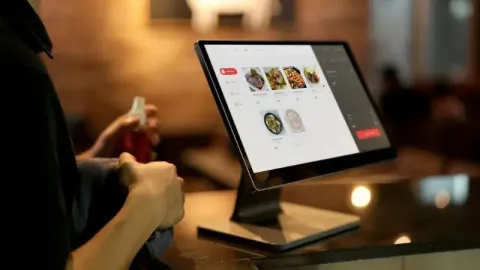
What is a Self-Service Restaurant?
A self-service restaurant is exactly what it sounds like. It’s a restaurant where you do most of the work yourself (except for the cooking, thankfully). You order, pay, and pick up your meal without interacting with the waitstaff.
You’ve probably been to one without even realizing it. Have you ever used a kiosk at McDonald’s? That’s self-service. Grabbed a plate at a buffet? Same deal. Even some fast-casual spots now have QR codes on tables so you can order without flagging down a server.
Types of Self-Service Restaurants
A self-service restaurant is a broad phrase as it has many forms. Ideally, you can classify it into any of the following three categories.
1. Buffet-Style

I’d be lying if I said I don’t love buffets. Who doesn’t? You walk in, grab a plate, and the whole spread is yours. You don’t have to wait for a server, worry about what you can or cannot pick, and even control your portions!
It is, hands down, the ultimate self-service dining experience. Instead of ordering from a menu and waiting for food to be brought to your table, you simply help yourself. The food is already prepared and laid out on a long table, and you can go back as many times as you like.
2. Self-Ordering Kiosks & QR Code Menus

A self-service kiosk takes efficiency and speeds up a notch. Instead of waiting in a queue to place an order at the counter, you just have to walk up to this freestanding booth. These kiosks have an interactive digital touchscreen with keyboards, barcode scanners, and even printers.
You can explore the restaurant’s menu, add items to your cart, and pay with your card to complete the checkout process. As if this wasn’t convenient enough, QR code menus go even beyond. Unlike the kiosks, you don’t even have to stand up here.
Such self-service restaurants usually have a QR code placed on the tables, chairs, or walls. Customers just have to scan it with their phone to view the menu, place an order, and pay online.
3. Automated Food Dispensers & Robotic Kitchens

You might think this is absurd and impossible, but it’s actually happening. Flippy, the burger-flipping robot, makes the best burgers and fries for only $3 per hour. The best part? It will work 24/7 without complaining or feeling tired!
And then there’s Smile Robotics, a robot that can serve you meals and pick up dirty plates after you’re done eating. It does its job smoothly and swiftly without needing any human intervention at all.
That’s not all. We live in a world with robot baristas, chefs, food delivery robots, automated food dispensers, and even robotic kitchens. While it might not be as common as of now, surely we’ve given an entirely new meaning to self-service!
Self-Service Supermarkets: How Automation is Changing Retail
The restaurants are not the only ones offering self-service. It seems the supermarkets are also jumping on the bandwagon. Chances are, you’ve already been to a self-service supermarket. Here’s an overview to jog your memory.

What is a Self-Service Supermarket?
Grocery shopping is hectic enough as is minus the small talk with the cashier. Besides, we all have those days when you just want to get in, grab your groceries, and get out without a single “How’s your day going?” moment.
Well, what do you know? Self-service supermarkets make it possible to keep your head down, get your groceries, and return home.
Instead of a cashier at the checkout counter, you’ll find machines where you can scan, bag, and pay for your items. The best part is that you can do all of this yourself without requiring help from the staff. Self-service supermarkets might be more common than you think. For example:
- Amazon Go
- Amazon Go unmanned retail store
Amazon created a cashier-less store that completely eliminated the need to wait in lines and interact with others. The idea was based on a simple concept. When customers entered the store, they would have to scan a QR code on the Amazon Go app. Now linked to their Amazon account, customers can walk around and shop freely.
The store was lined with cameras and sensors that mentored every item a customer picked and kept back on the shelf. When leaving the store, Amazon would automatically charge them for the items in their cart via their account.
- Self-Checkout Kiosks in Walmart, Tesco, Carrefour
As you can probably guess by the name, these self-checkout kiosks mean scanning and paying for your items yourself. Walmart, Tesco, and Carrefour are only three of the many supermarket chains to implement this latest technology.
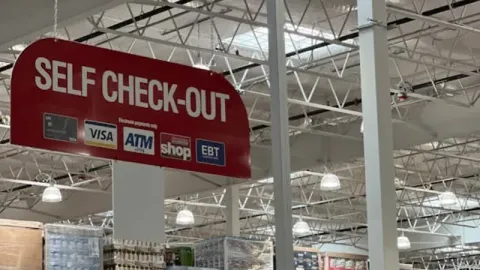
- AI-Powered Smart Carts & Mobile Scan-and-Go Apps
Overspending on a grocery trip is something we’re all guilty of. Smart carts help you avoid that walk of shame to your car. They will sense, scan, and weigh the items as you throw them in the cart. You’ll see a small screen displaying your running total.
This way, you’ll be wary of your shopping pattern and may be able to avoid overspending. Scan-and-Go apps allow you to shop without carrying around an actual cart. You can add the items to your virtual cart and pay from your phone before leaving the store.
Benefits of Self-Service Supermarkets
Now, let’s take a look at the benefits a self-service supermarket provides.

1. Faster Checkout & Reduced Queues
Did you know an average consumer makes around two trips to a grocery store per week? Now it makes sense why those places are always crowded. Doesn’t it? With self-service supermarkets, managing more people is easier due to increased speed and reduced waiting time.
2. Lower Labor Costs for Retailers.
Self-service technology might be expensive upfront, but think about the money you’ll save long-term. Labor costs are one of the biggest expenses of retail stores. Introducing self-service options means you can save on that!
3. Enhanced Customer Experience & Convenience
All customers appreciate quicker service, and self-service options make it easy. With no lines to wait in and no related inconveniences, your customers will definitely enjoy shopping at your store.
The Role of Self-Service Technology in Restaurants & Supermarkets
Technology is obviously indispensable in making self-service restaurants and supermarkets a success. However, both these places don’t really use the same tech. For instance, you’ll find self-ordering kiosks and food preparation robots in restaurants. But in supermarkets, you’re more likely to find an AI-powered checkout service or RFID smart carts (more on this later)!
However, restaurants and supermarkets share one technology in common: a mobile ordering app. I mean, not having this would defeat the purpose, wouldn’t it?

How Self-Service Technology Works
You might be wondering how the technologies described above actually work. Well, here is a brief explanation.
- Self-Order Kiosks & Digital Menus in Restaurants: These are touchscreens where you can look at the menu, choose your food, and pay without talking to anyone. It makes ordering faster and helps avoid long lines.
- AI-Powered Cameras & RFID Scanners in Supermarkets: AI cameras watch what items you pick up, while RFID tags (tiny chips) on products let scanners know what’s in your cart. This helps track purchases automatically so you can shop faster.
- Automated Billing & Contactless Payments: The system keeps track of items in your cart. When it’s time to check out, you tap your card or mobile on a reader, and voila – you’re done without having to handle cash or cards!
Claim Self-Service: What Does It Mean?
If you thought self-service technology was only limited to when you order and buy something, here’s a spoiler: it also works for refunds and returns!
What is Claim Self-Service?
No offense, but robots are better listeners than humans. This especially holds true when customers come in claiming returns or refunds. Claim Self-Service allows you to let your human customer reps off the hook.
Instead, customers can just access information, solve their issues, and make payments at the self-service portal. For example, some online stores have refund portals where customers can request money back without calling support.
Provider Self-Service: Finding the Right Self-Service Solutions
Do you think we’re done? No, there’s more, namely, Provider Self-Service. As always, let’s start by learning the basics.

What is Provider Self-Service?
Let’s say you want to introduce self-service solutions to your business. Do you build the technology yourself? No! You contact a provider self-service. These are self-service service providers for businesses. They take the time to understand your needs and then develop the right solutions for you.
Here are the top self-service technology providers for restaurants & supermarkets:
- SwiftForce for all things self-service like self-service kiosks, smart carts, desktop all-in-one POS, and smart scale
- Oracle for POS software-powered kiosks
- Elo for front-of-house and back-of-house operations
- Deliverect self-ordering systems
- Flooid for self-checkout solutions
How to Implement Self-Service in Your Business
If you’re thinking about implementing self-service in your business, you just need to follow the following three simple steps.
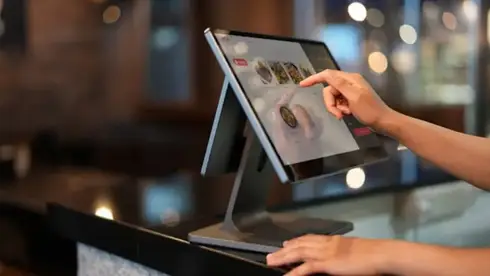
Step 1: Identify the Right Self-Service Model
Start by determining your needs, as it will help you narrow down your choices. For instance, a supermarket owner shouldn’t get a QR code menu model. It’s completely useless to him. Hence, you must do your research to figure out which model is worth your investment.
Step 2: Choose the Right Technology Provider
No, not all self-checkout solutions are the same. Brands matter. And so does the after-sales service. It’s a huge investment, so make sure you’re trusting the right provider. Ask for reviews and referrals, and compare pricing and services.
It’s also a good idea to ensure the new technology easily integrates with your existing systems. Also, prefer user-friendly solutions as they’re easier to adapt to.
Step 3: Optimize Customer Experience & Staff Training
When you finally have your hands on self-service solutions, introduce them to your staff and customers gradually. Make sure to train your team so they know their way around it. As for your customers, assign a staff member to guide them for at least until they are comfortable.
Challenges & Future Trends in Self-Service Technology
Despite being impressive, self-service technology isn’t without some challenges. Let’s see what they are.
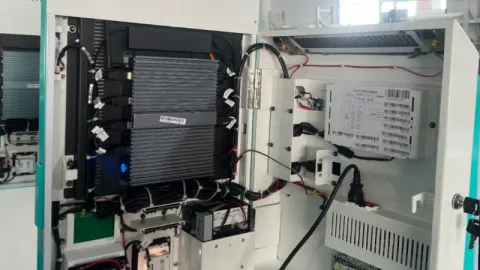
Common Challenges in Self-Service Adoption
Businesses are sometimes hesitant to adopt self-service technology, and here’s why:
- Technical Issues & Maintenance Costs: As with any tech, you’re likely to run into technical issues with self-service solutions occasionally. Plus, maintenance costs to ensure the system runs smoothly are an ongoing expense.
- Customer Hesitation & Learning Curve: Many customers hesitate to use new technology, especially when it asks them for sensitive information. Besides, these systems can be complicated for older citizens, and the learning curve can be steep.
- Security Concerns: Cashier-less stores are more susceptible to attempts of theft and shoplifting. This is one major reason why many retail businesses have yet to adopt self-service solutions.
Future of Self-Service: What’s Next?
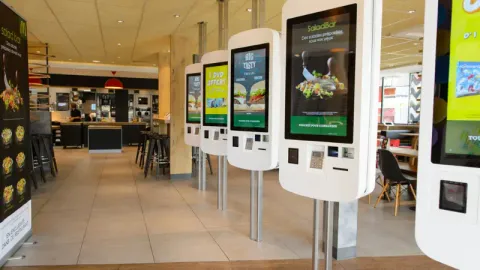
Considering the progress made by self-service solutions in so little time, it’s clear they’re here to stay. So, what does the future look like? Based on our research, AI-powered chatbots will soon be enough to take over handling customer inquiries and orders.
We’ll also have voice-activated ordering systems for non-tech-savvy customers, who can place their orders verbally. And, of course, biometric payment systems will completely eradicate any security concerns.
These features are already here, and who knows, maybe one day, you’ll just think about your order, ask the AI about what you want, robots will prepare your meal, and a drone will drop it off!
FAQs About Self-Service Restaurants & Supermarkets

What is a self-service restaurant?
It’s a restaurant where customers can order, pay, and pick up food without having to interact with a waiter at all. Customers interact with a digital kiosk and place their orders through the system.
Are self-service supermarkets replacing cashiers?
While self-service supermarkets are becoming common by the day, they are not entirely placing cashiers. However, many self-service supermarkets have fewer cashier staff now.
How does claim self-service work?
It lets customers handle refunds, returns, and service requests without talking to staff.
Who are the top providers of self-service technology?
Among many others, Zoho Desk, Intercom, Pan Oston, and DynaTouch are the leading self-service technology providers.
Is self-service technology expensive to implement?
Yes, the initial cost to implement self-service technology can be expensive. However, if you compare the cost savings it offers in the long run, it is a highly cost-effective solution.
Conclusion
It’s no secret that self-service technology that powers a self-service restaurant is shaping and improving how we perceive restaurants and supermarkets. It’s only a matter of time before customers altogether abandon businesses that don’t offer similar services.
Make sure you climb aboard before that happens. After all, improving efficiency and customer experience is what makes every business successful.
SwiftForce: Get Self-service Restaurant Solutions
Looking for the right solution for your business?Explore SwiftForce’s full range of hardware solutions and get in touch with our team for expert guidance tailored to your needs.



